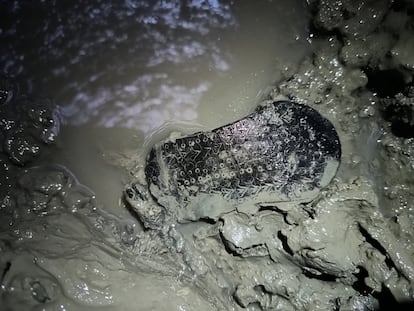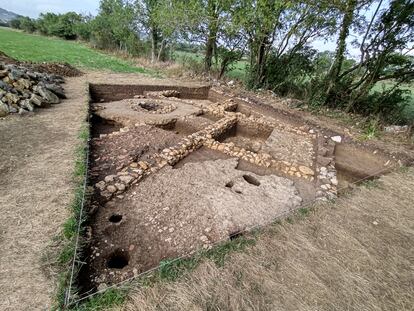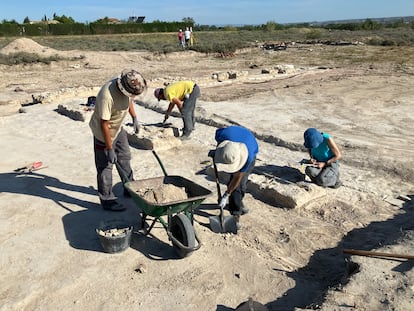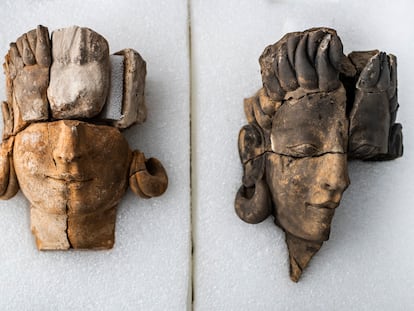The Roman well-cleaner who lost a sandal 2,000 years ago in Spain
The footwear, the only example from Hispania discovered with decorative elements, is in an excellent state of preservation and has been refrigerated until it can be fully restored


Lucus Asturum (modern-day Lugo de Llanera in Asturias, northern Spain) was a Roman settlement that served as an administrative center and communications hub in the north of the Iberian Peninsula between the first and fourth centuries A.D., and which, given its importance, the Greek astronomer, mathematician, and geographer Ptolemy reported in his famous work Geography. As such, Lucus Asturum contained many important public and private buildings. In 2021, a team led by archaeologist Esperanza Martín located a large house with a central courtyard and a well. This summer, excavations at the site were resumed and the archaeologists decided to descend, using a system of pulleys to avoid damaging the remains, to the bottom of the well.
Inside, among many other Roman pieces, they found a sandal lost by a man who tried to clean the well 2,000 years ago. Despite the humbleness of the object, it is a unicum — an archaeological object without equal — because it is decorated with circles, ovals and falciform figures. There are no more than 20 Roman sandals preserved in Hispania and this is the only one that is decorated. It is in a good state of preservation, as the silt at the bottom of the well generated an anaerobic system that prevented the reproduction of microorganisms.

The existence of Lucus Asturum has been known since ancient times, but trace of the settlement was lost centuries ago until the Provincial Commission of Monuments carried out the first excavations in the 1930s. However, all the archaeological material found, as well as the related documentation, has since been lost or destroyed. In 1989, Carmen Fernández Ochoa’s team located a votive altar on the site dedicated to the lares viales (household divinities), a medieval necropolis, and Alto-Imperial remains from the 1st century A.D. In 2018, promoted and financed by the Llanera City Council, excavations were reinitiated.
On this occasion, the archaeologists used non-invasive techniques such as the Lidar laser detection system, geophysical surveys, satellite imagery, and thermography. Thus, they found that under the grass of the meadows “there was an archaeological substrate” that included some large and extensively plundered baths, as well as a well-preserved canal. But the Covid-19 pandemic brought a halt to the work. When it was resumed, in 2021, the team detected a garbage dump used between the first and fourth centuries, several buildings separated by a road and “a large residential nucleus” with the aforementioned well, which retains the stonework marks of those who opened it up two millennia ago.

“The remains we found, due to the anoxia generated by the high water table in the area, are in an exceptional state,” says Martín. “The silts have created an anaerobic environment thanks to the plasticity of the clays that compose them, so the organic materials have been perfectly preserved.” At a depth of about three meters, the specialists extracted part of the wooden cover of the well, a tiled floor for the decantation of silts, several jars, seeds, chestnuts, pine nuts, mollusks, the remains of domestic and wild fauna, an acetre, or bronze, cauldron, a small metal ring and the sandal, among other objects. “It is almost complete and retains the cutting notches to hold it in the upper leg area. It is more than likely that it was lost by someone who came in to clean [the well] when it got caught in the silt. It is a unique object as it is decorated.”
The footwear is currently refrigerated to avoid degradation until it can be restored and exhibited in the Archaeological Museum of Asturias. The sandal will thus tell visitors the story of how 2,000 years ago, a rather well-dressed individual descended into a well in Lucus Asturum to extract the mud that was spoiling the water supply to his home.
Sign up for our weekly newsletter to get more English-language news coverage from EL PAÍS USA Edition
Tu suscripción se está usando en otro dispositivo
¿Quieres añadir otro usuario a tu suscripción?
Si continúas leyendo en este dispositivo, no se podrá leer en el otro.
FlechaTu suscripción se está usando en otro dispositivo y solo puedes acceder a EL PAÍS desde un dispositivo a la vez.
Si quieres compartir tu cuenta, cambia tu suscripción a la modalidad Premium, así podrás añadir otro usuario. Cada uno accederá con su propia cuenta de email, lo que os permitirá personalizar vuestra experiencia en EL PAÍS.
¿Tienes una suscripción de empresa? Accede aquí para contratar más cuentas.
En el caso de no saber quién está usando tu cuenta, te recomendamos cambiar tu contraseña aquí.
Si decides continuar compartiendo tu cuenta, este mensaje se mostrará en tu dispositivo y en el de la otra persona que está usando tu cuenta de forma indefinida, afectando a tu experiencia de lectura. Puedes consultar aquí los términos y condiciones de la suscripción digital.










































